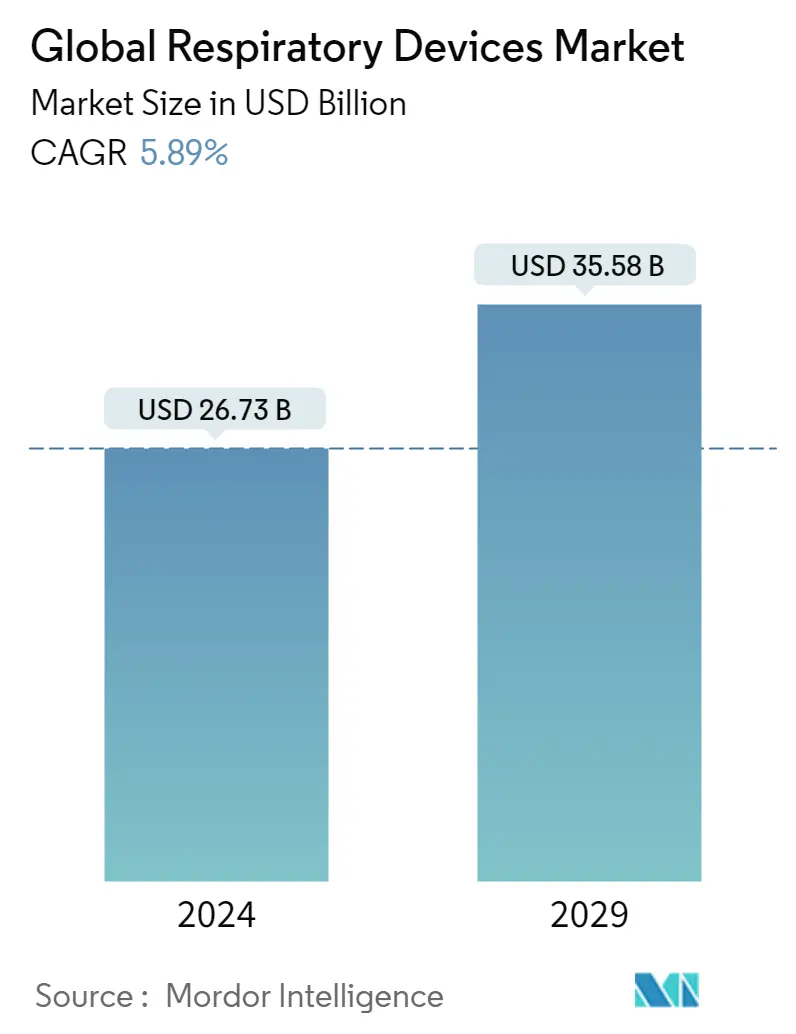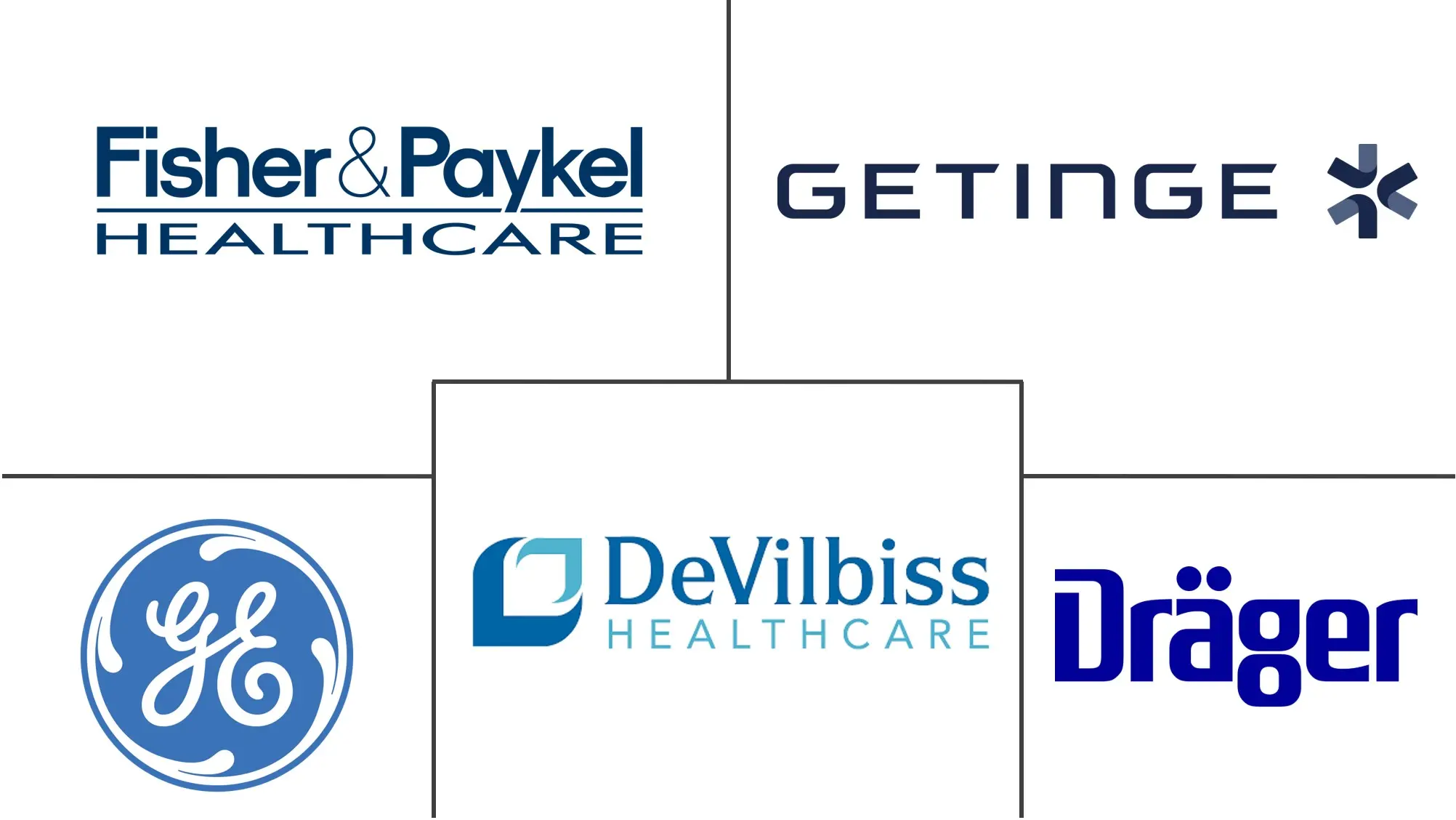Market Size of Global Respiratory Devices Industry

| Study Period | 2019 - 2029 |
| Market Size (2024) | USD 26.73 Billion |
| Market Size (2029) | USD 35.58 Billion |
| CAGR (2024 - 2029) | 5.89 % |
| Fastest Growing Market | Asia-Pacific |
| Largest Market | North America |
Major Players
*Disclaimer: Major Players sorted in no particular order |
Need a report that reflects how COVID-19 has impacted this market and its growth?
Respiratory Devices Market Analysis
The Global Respiratory Devices Market size is estimated at USD 26.73 billion in 2024, and is expected to reach USD 35.58 billion by 2029, growing at a CAGR of 5.89% during the forecast period (2024-2029).
The COVID-19 pandemic had a substantial impact on the respiratory devices market initially. However, the respiratory device market grew significantly as a result of government initiatives and policies, as well as the company's strategic developments to overcome the shortfall. For instance, in May 2021, the Global Fund approved USD 75 million in fast-track funding to support India's response to the COVID-19 crisis. This new funding helped India purchase oxygen concentrators and pressure swing adsorption (PSA) oxygen plants to help meet the country's medium-term medical oxygen needs. Hence, due to the surge in COVID-19 cases, the demand for respiratory devices increased, thereby fueling the growth of the market. However, as COVID-19 cases declined and the pandemic accelerated the use of respiratory devices, the studied market is now expected to project stable growth over the studied period.
The major factor broadly acting as a driving factor includes the increasing prevalence of respiratory disorders, such as COPD, TB, asthma, and sleep apnea, and technological advancements and their increasing applications in a homecare setting. For instance, according to the World Health Organization update, in October 2022, the 30 high-TB burden countries accounted for 87% of new TB cases. The largest number of new TB cases occurred in the WHO South-East Asian Region, with 46% of new cases, followed by the WHO African Region, with 23% of new cases, and the WHO Western Pacific, with 18%. Such an increase in TB cases leads to rising demand for respirators, thereby driving the growth of the market. Additionally, according to the CDC update, in December 2022, the percentage of adults aged 18 and over who had asthma was 8.0%, and that of children under the age of 18 was 6.5% in 2021. Thus, as the number of people with asthma goes up, so does the need for inhalers, which makes the market grow.
Furthermore, technology and improvements in artificial intelligence have dramatically changed the healthcare sector. Various market players are investing and innovating in the advancement of respiratory devices. For instance, in November 2022, Xplore Health Technologies launched a first-of-its-kind respiratory muscle training (RMT) device called Airofit Pro. The product comes from a collaboration with Airofit, Denmark. It was one of the first data-driven smart respiratory training systems and is priced at USD 422.74 (Rs 34,990). Airofit Pro personalizes the breathing training experience for users and makes their respiratory muscles stronger, faster, and more efficient. Therefore, with such technological advancements in respiratory devices, the market is expected to grow over the forecast period.
Hence, as a result of the above-mentioned factors, such as the increasing prevalence of respiratory disorders and technological advancements and increasing applications in a homecare setting, the respiratory device market is anticipated to grow over the forecast period. However, the high cost of devices is likely to restrain the market's growth.
Respiratory Devices Industry Segmentation
As per the scope of the report, respiratory devices include respiratory diagnostic devices, therapeutic devices, and breathing devices for administering long-term artificial respiration. It may also include a breathing apparatus used for resuscitation by forcing oxygen into the lungs of a person who has undergone asphyxia. The Respiratory Devices Market is Divided Into Type (Diagnostic and Monitoring Devices (Spirometers, Sleep Test Devices, Peak Flow Meters, Pulse Oximeters, Capnographs, and Other Diagnostic and Monitoring Devices), Therapeutic Devices (CPAP Devices, BiPAP Devices, Humidifiers, Nebulizers, Oxygen Concentrators, Ventilators, Inhalers, and Other Therapeutic Devices), and Disposables (Ma The market report also covers the estimated market sizes and trends for 17 different countries across major regions globally. The report offers the value (in USD million) for the above segments.
| By Type | ||||||||||
| ||||||||||
| ||||||||||
|
| Geography | ||||||||
| ||||||||
| ||||||||
| ||||||||
| ||||||||
|
Global Respiratory Devices Market Size Summary
The respiratory care devices market is poised for significant growth over the forecast period, driven by the increasing prevalence of respiratory disorders such as COPD, tuberculosis, asthma, and sleep apnea. Technological advancements and their expanding applications in homecare settings are further propelling market expansion. The COVID-19 pandemic initially impacted the market, but subsequent government initiatives and strategic developments by companies led to a surge in demand for respiratory devices. This demand was particularly evident in regions like India, where funding was allocated to enhance medical oxygen supply capabilities. As the pandemic's impact wanes, the market is expected to experience stable growth, supported by ongoing technological innovations and the rising need for respiratory care solutions.
North America is anticipated to maintain a dominant position in the respiratory devices market, attributed to the high burden of respiratory diseases and robust research and development activities in the region. The United States, in particular, is investing significantly in R&D for respiratory conditions, fostering the development of advanced devices. Additionally, market players are actively engaging in product launches and strategic partnerships to enhance their offerings. The competitive landscape is moderately consolidated, with key players like GE Healthcare, Koninklijke Philips N.V., and Medtronic PLC leading the market. Despite the high cost of devices posing a potential restraint, the overall market outlook remains positive, driven by innovation and increasing demand for respiratory care.
Global Respiratory Devices Market Size - Table of Contents
-
1. MARKET DYNAMICS
-
1.1 Market Overview
-
1.2 Market Drivers
-
1.2.1 Increasing Prevalence of Respiratory Disorders, such as COPD, TB, Asthma, and Sleep Apnea
-
1.2.2 Technological Advancements and Increasing Applications in Homecare Setting
-
-
1.3 Market Restraints
-
1.3.1 High Cost of Devices
-
-
1.4 Porter's Five Forces Analysis
-
1.4.1 Threat of New Entrants
-
1.4.2 Bargaining Power of Buyers/Consumers
-
1.4.3 Bargaining Power of Suppliers
-
1.4.4 Threat of Substitute Products
-
1.4.5 Intensity of Competitive Rivalry
-
-
-
2. MARKET SEGMENTATION (Market Size by Value - USD Million)
-
2.1 By Type
-
2.1.1 Diagnostic and Monitoring Devices
-
2.1.1.1 Spirometers
-
2.1.1.2 Sleep Test Devices
-
2.1.1.3 Peak Flow Meters
-
2.1.1.4 Pulse Oximeters
-
2.1.1.5 Capnographs
-
2.1.1.6 Other Diagnostic and Monitoring Devices
-
-
2.1.2 Therapeutic Devices
-
2.1.2.1 CPAP Devices
-
2.1.2.2 BiPAP Devices
-
2.1.2.3 Humidifiers
-
2.1.2.4 Nebulizers
-
2.1.2.5 Oxygen Concentrators
-
2.1.2.6 Ventilators
-
2.1.2.7 Inhalers
-
2.1.2.8 Other Therapeutic Devices
-
-
2.1.3 Disposables
-
2.1.3.1 Masks
-
2.1.3.2 Breathing Circuits
-
2.1.3.3 Other Disposables
-
-
-
2.2 Geography
-
2.2.1 North America
-
2.2.1.1 United States
-
2.2.1.2 Canada
-
2.2.1.3 Mexico
-
-
2.2.2 Europe
-
2.2.2.1 Germany
-
2.2.2.2 United Kingdom
-
2.2.2.3 France
-
2.2.2.4 Italy
-
2.2.2.5 Spain
-
2.2.2.6 Rest of Europe
-
-
2.2.3 Asia-Pacific
-
2.2.3.1 China
-
2.2.3.2 Japan
-
2.2.3.3 India
-
2.2.3.4 Australia
-
2.2.3.5 South Korea
-
2.2.3.6 Rest of Asia-Pacific
-
-
2.2.4 Middle East and Africa
-
2.2.4.1 GCC
-
2.2.4.2 South Africa
-
2.2.4.3 Rest of Middle East and Africa
-
-
2.2.5 South America
-
2.2.5.1 Brazil
-
2.2.5.2 Argentina
-
2.2.5.3 Rest of South America
-
-
-
Global Respiratory Devices Market Size FAQs
How big is the Global Respiratory Devices Market?
The Global Respiratory Devices Market size is expected to reach USD 26.73 billion in 2024 and grow at a CAGR of 5.89% to reach USD 35.58 billion by 2029.
What is the current Global Respiratory Devices Market size?
In 2024, the Global Respiratory Devices Market size is expected to reach USD 26.73 billion.

